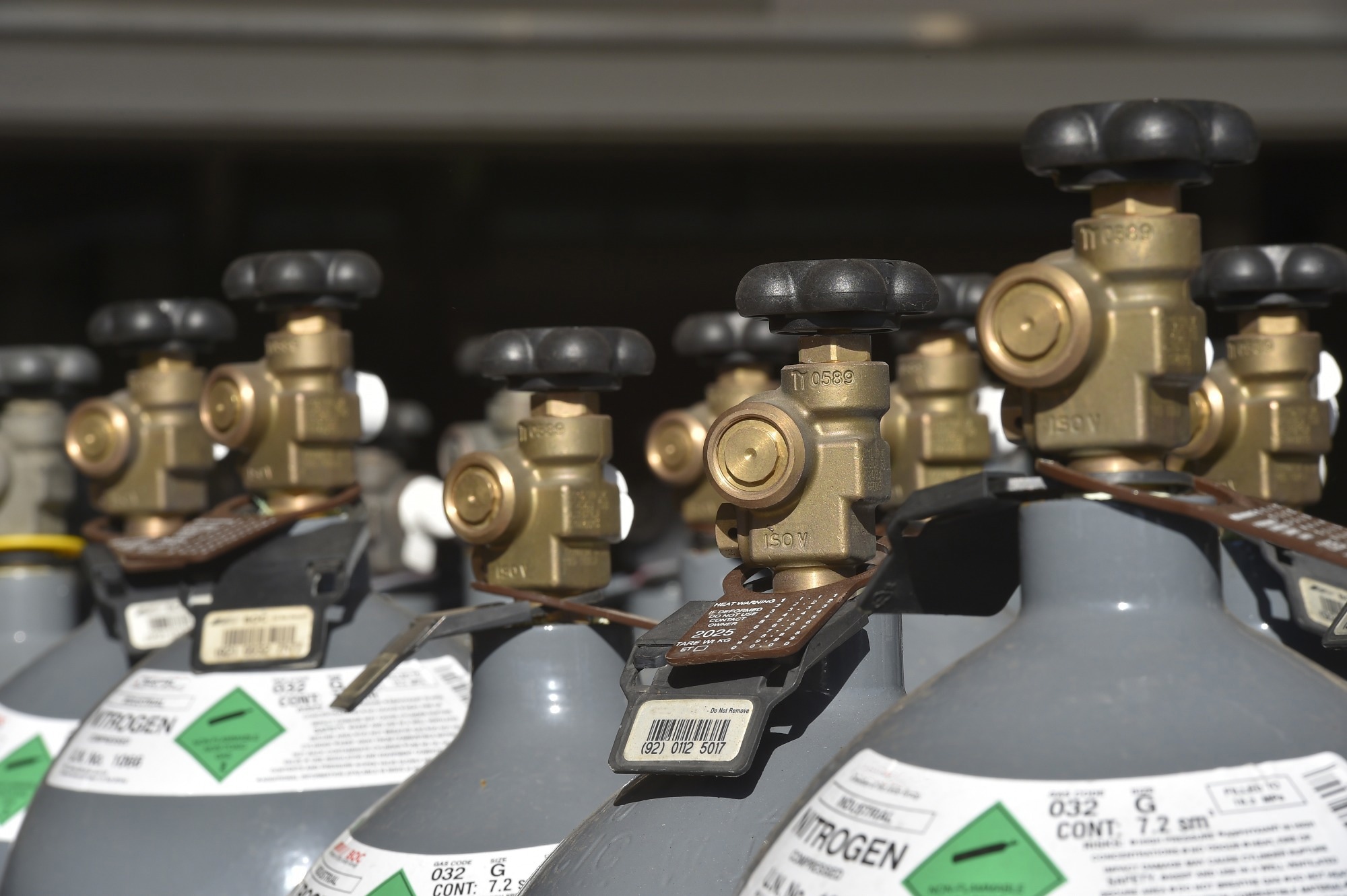High-purity gases act as reagents, leak detectors, process gases, and chromatography carriers across the pharmaceutical supply chain. This article will outline the most common pharmaceutical gases and their uses in the pharmaceutical industry.

Image Credit: xshot/Shutterstock.com
Nitrogen
Nitrogen (N2) is the most commonly utilized gas in the pharmaceutical sector, aside from air.1 This is due to two factors. For starters, nitrogen is a key component of the atmosphere, and hence, it is plentiful. Second, nitrogen is chemically inert.
Nitrogen is a powerhouse in the pharmaceutical sector, where it is often employed for blanketing, purging, pressurizing, and mixing due to these qualities.
Nitrogen is also used to protect delicate precursors, reagents, and pharmaceutical products from reacting with oxygen in the air since it is non-reactive. Nitrogen is utilized as a packing gas in blister packs and sterile form-fill-seal (FFS) vials2 to preserve pharmaceuticals from deterioration.
Nitrogen can also be used as a pressurizing agent to check for leaks in process equipment (such as tanks, vessels, and pipes). The gas is also used to discharge or transfer other fluids from storage tanks and reservoirs in a similar manner.
Furthermore, in gas chromatography, nitrogen is frequently utilized as a carrier gas.3 The purity of the nitrogen carrier gas is crucial in chromatography applications since any contaminants are likely to be discovered during analysis.
The use of ultra-high-quality nitrogen gas decreases the chromatographic analysis’ effective noise floor, allowing for more precise identification of contaminants in pharmaceutical goods.
Oxygen
In pharmaceutical synthesis, oxygen (O2) is an important reagent. Oxygen, perhaps one of the greenest oxidizing agents accessible to an organic chemist, is usually used in the form of “synthetic air”, which is a combination of roughly 10% oxygen with nitrogen that prevents the combustion threat associated with pure oxygen.4
In biopharmaceutical applications, oxygen is employed to manufacture pharmaceutical chemicals in fermenters using cell cultures. Since ambient oxygen concentrations are often insufficient for application in bioreactors, pure oxygen is used to “enrich” the internal environment, enhancing growth rates and productivity.
Carbon Dioxide
Carbon dioxide (CO2) is inert, much like nitrogen. As a result, it is ideal for general-purpose blanketing and packing. It also plays a vital role in pharmaceutical production.
In the pharmaceutical industry, carbon dioxide is employed as a supercritical fluid. Fluids can exist in a supercritical state, which is an intermediate state between liquid and gas, at high temperatures and low pressures.
Carbon dioxide is the most widely utilized supercritical fluid in the pharmaceutical industry, and it is essential for organic compound extraction.5,6 Carbon dioxide is also used for “micronization”, which is the process of producing very tiny particles of active medicinal substances.7
Pharmaceutical-Grade Gases from Air Products
Purity is crucial at every level in the pharmaceutical industry. Impurities in pharmaceutical gases, such as water vapor or reactive species, can cause sensitive precursors or pharmaceutical products to react.
These erroneous reactions can reduce yields, hasten product deterioration, and cause inaccuracies in analytical operations. The purity of pharmaceutical goods is critical, and this can only be achieved reliably with the use of ultrapure process gases.
Any pharmaceutical company must locate a reliable gas provider that can assist with all elements of gas usage. Air Products is happy to serve the pharmaceutical sector as a leading provider of ultra-high-purity gases.
The company has built solid connections with pharmaceutical customers and has helped them expand by providing a variety of supply options to meet their requirements.
Air Products deliver pharmaceutical-grade nitrogen, oxygen, and carbon dioxide that is manufactured, assessed, stored, and supplied in strict accordance with regulatory requirements.
The pharmaceutical gases from the company are purified to ultra-high purity levels, exceeding the European Pharmacopeia and Good Manufacturing Practice (GMP), Part II, as well as the Japanese and US Pharmacopeia.
Air Products BIP® gases provide the greatest levels of purity for the most demanding pharmaceutical applications.
Without the need for extra equipment, the unique BIP® filtration technology filters out pollutants at the point of use, giving ultra-high-purity gas with the lowest possible quantities of important contaminants such as undesired oxygen and water vapor.
Contact the team to find out more about Air Products' ultra-pure gases for pharmaceutical applications.
References
- Sandle, T. Microbiological Assessment of Compressed Gases in Pharmaceutical Facilities. Journal of Validation Technology 21, 1–8 (2015).
- Baseman, H. Sterile product manufacture using form fill seal technologies. in Advanced Aseptic Processing Technology (CRC Press, 2010).
- Jwaili, M. Pharmaceutical Applications of Gas Chromatography. Open Journal of Applied Sciences 9, 683–690 (2019).
- Hone, C. A., Roberge, D. M. & Kappe, C. O. The Use of Molecular Oxygen in Pharmaceutical Manufacturing: Is Flow the Way to Go? ChemSusChem 10, 32–41 (2017).
- Kaiser, C. S., Römpp, H. & Schmidt, P. C. Pharmaceutical applications of supercritical carbon dioxide. Pharmazie 56, 907–926 (2001).
- Kitada, K. et al. Supercritical CO2 extraction of pigment components with pharmaceutical importance from Chlorella vulgaris. J. Chem. Technol. Biotechnol. 84, 657–661 (2009).
- Rogers, T. L., Johnston, K. P. & Williams, R. O. Solution-Based Particle Formation of Pharmaceutical Powders by Supercritical or Compressed Fluid CO2 and Cryogenic Spray-Freezing Technologies. Drug Development and Industrial Pharmacy 27, 1003–1015 (2001).

This information has been sourced, reviewed and adapted from materials provided by Air Products PLC.
For more information on this source, please visit Air Products PLC.